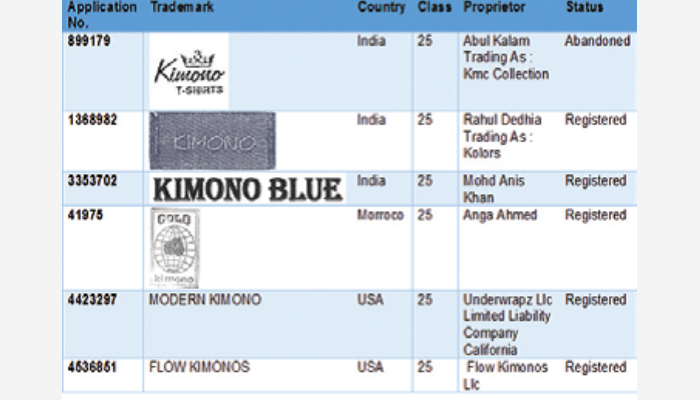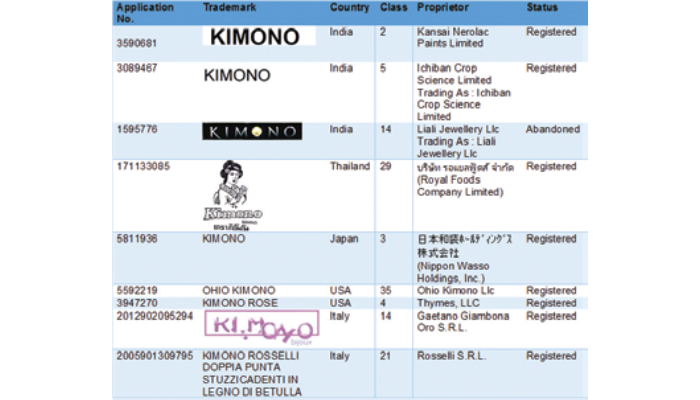
or

Take inspiration from indigenous cultures without being accused of cultural appropriation – Italian designer Maurizio Galante
For the past few days Twitter is welcoming its users with the hashtag #KimOhNo. Last week, reality TV star Kim Kardashian launched her shapewear line called KIMONO, which was supposedly a play on her name and the word “ono,” another word for one. However, soon after announcement she got into hot water and faced severe backlash from members of Japanese community who accused her of CULTURAL APPROPRIATION. The anger bars got raised after it was reported by a news daily, Business Insider, that various trademark applications for “Kimono” including variations on the name were filed with the USPTO.
This once again brought into the limelight a rather contentious issue in IP Law, which is Cultural Appropriation. Fashion world and cultural appropriation have had a long-term relationship with each other. For example, American clothing retailer Urban Outfitters made headlines in 2011 when it issued Navajo themed items, including underwear with traditional patterns, much to the discontent of the Navajo Nation. Likewise, French designer Isabel Marant was criticized in 2015 for designing a dress similar to a traditional blouse that has been made for centuries by the Mixe people, an Indigenous community in Mexico.4 A small fashion brand ‘People’s Tree’ brought out an action against high fashion brand Dior, for allegedly reproducing one of the block painting designs in its ‘Dior’s Cruise 2018’ collection. The design in question consisted of block printed images of yoga postures, which ‘People’s Tree’ claimed was a traditional technique of printing.
Oxford Dictionary, defines cultural appropriation as “the unacknowledged or inappropriate adoption of the customs, practices, ideas, etc. of one people or society by members of another and typically more dominant people or society.” Susan Scafidi, a law professor at Fordham, defines it as “Taking intellectual property, traditional knowledge, cultural expressions, or artifacts from someone else’s culture without permission. This can include unauthorized use of another culture’s dance, dress, music, language, folklore, cuisine, traditional medicine, religious symbols, etc. It’s most likely to be harmful when the source community is a minority group that has been oppressed or exploited in other ways or when the object of appropriation is particularly sensitive, e.g. sacred objects.”
In this particular instance, Kardashian was accused of ripping off a highly celebrated and traditional garment. Critics were of the view that her choice of “kimono” not only disrespected Japanese culture but also disregarded the significance of the traditional outfit.
An open letter was also sent by the mayor of Kyoto, Daisaku Kadokawa, which he shared on his official facebook page, wherein he said that “Kimono is a traditional ethnic dress fostered in our rich nature and history with our predecessors’ tireless endeavours and studies and it is a culture that has been cherished and passed down with loving care. Also, it is a fruit of craftsmanship and truly symbolises the sense of beauty, spirits and values of Japanese.”
Yuko Kato, a BBC News Japanese Editor, further explained in her Twitter thread why usage of the name Kimono was so egregious. She stated that ‘Basically, what you’re doing is creating a line of underwear and calling them, ‘traditional Japanese garments’. Is that what you’re aming for? Or, or are you intentionally taking a Japanese word of specfic and extreme cultural significance, stripping away its meaning, and appropriating it for your brand? I do hope not, but intentional or otherwise, that will be the result. That’s why many Japanese are crying foul. Japanese – American woman Yuka Ohishi, told the BBC: “We wear kimonos to celebrate health, growth of children, engagements, marriages, graduations, at funerals. It’s celebratory wear and passed on in families through the generations. This shapewear doesn’t even resemble a kimono – she just chose a word that has Kim in it – there’s no respect to what the garment actually means in our culture.”
However, an interesting aspect to note here is that KIMONO seems to be a popular word amongst brand owners around the world and some have obtained registration for the same. Plenty of brands use the word “kimono” to sell flowy, robe like apparel that does not particularly resemble any traditional kimono. The word often is used as shorthand to indicate an item is supposedly inspired by Japanese clothing, but it is more like a caricature than any authentic representation. Details of some KIMONO trademarks as per the records of the Indian Trademark Registry and WIPO Global Brand Database is given below:
KIMONO as a trademark is also used for goods other than apparels. Details of some KIMONO trademarks as per the records of the Indian Trademark Registry and WIPO Global Brand Database is given below:

One week later after fierce rebukes online Kim Kardashian has decided to take back the name KIMONO and announced that she would be relaunching the line with a new name soon. Explaining herself she said in her official statement that she launched the line with the “best intentions in mind,” her brands and products are “built with inclusivity and diversity at their core and after careful thought and consideration”.
Nevertheless, one important issue that needs to be addressed is the threshold between cultural inspiration and cultural appropriation especially when cultures globally interact with each other.
Vikrant Rana is the Managing Partner of S.S Rana & Co., a premier Intellectual Property Law Firm of India. As an Advocate-on-Record with the Supreme Court of India (2006) and registered as a Patent Agent in 1998, Vikrant has been litigating in courts all over India, primarily at the Supreme Court of India, various High Courts across the country, Trademarks Registry, Patent Office, Intellectual Property Appellate Board and the Copyright Board of India.
Isheta Srivastava is an Associate Advocate at S.S. Rana & Co., a premier Intellectual Property Law Firm. She is a registered Advocate with Bar Council of India. She has completed her graduation from Symbiosis Law School, Noida and has done her Masters in Intellectual and Technology Law from National University of Singapore. She is skilled in Research and her areas of focus Intellectual Property Rights, Innovation and Information policy.

Lex Witness Bureau

Lex Witness Bureau

Lex Witness Bureau

For over 10 years, since its inception in 2009 as a monthly, Lex Witness has become India’s most credible platform for the legal luminaries to opine, comment and share their views. more...
Connect Us:


The Grand Masters - A Corporate Counsel Legal Best Practices Summit Series
www.grandmasters.in | 8 Years & Counting
The Real Estate & Construction Legal Summit
www.rcls.in | 8 Years & Counting
The Information Technology Legal Summit
www.itlegalsummit.com | 8 Years & Counting
The Banking & Finance Legal Summit
www.bfls.in | 8 Years & Counting
The Media, Advertising and Entertainment Legal Summit
www.maels.in | 8 Years & Counting
The Pharma Legal & Compliance Summit
www.plcs.co.in | 8 Years & Counting
We at Lex Witness strategically assist firms in reaching out to the relevant audience sets through various knowledge sharing initiatives. Here are some more info decks for you to know us better.
Copyright © 2020 Lex Witness - India's 1st Magazine on Legal & Corporate Affairs Rights of Admission Reserved